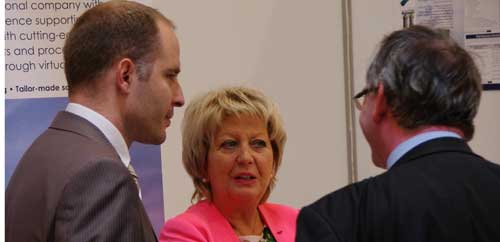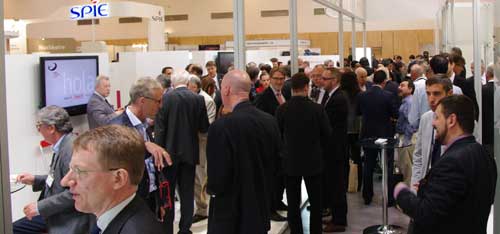

ENC 2014: Day 2 Plenary session: the many applications of nuclear technology
Many citizens probably know little about the many non-electricity-generation applications of nuclear technology. They probably aren’t very aware of just how much nuclear technology is part of their everyday lives. On Day 2 of ENC 2014 the opening Plenary Session, which was entitled: Nuclear technology for life sciences and other applications, was chaired by Frank Deconinck, of the Vrije Universiteit Brussels. Some of the many applications of nuclear technology were duly spotlighted during the session. Here is a blow-by-blow account of the session (Editor-in-Chief)
Sensitivity to low doses during mammography
The first speaker to address ENC 2014 delegates was Nicolas Foray of INSERM, France’s National Institute for health and Medical Research. The title of his presentation was Hypersensitivity to low doses during mammography. Mr Foray first set the scene with regards to breast cancer, emphasising how men too – contrary to popular belief – can get breast cancer too. He then gave a historical overview of the research that has been carried out into radio-sensitivity since the early 1900s, highlighting the work of Pierre Curie on radiation-induced burns, the discovery of DNA damage resulting from exposure to low dose radiation and the associated cancers and genetic syndromes. He then focused on the main theme of his presentation, namely hypersensitivity to low doses of radiation and the consequences it can have for women who undergo a mammography. He concluded that key factors influencing radio-sensitivity to low dose radiation include repetition doses and individual risk factors. He also outlined how individual radio-sensitivity levels are a reality when it comes to high doses, and that predictive assays for personalised treatment are available for those with such radio-sensitivity.

Applied medical research: saving lives globally
Research into ever more high performance mammography, especially with regards to those women with high radio-sensitivity levels, is therefore a priority for nuclear medicine researchers. One area of R&D focus is predictive radio-sensitivity trials, including those carried out by INSERM’s Centre for Cancer Research, in Lyon, which are carried out within the Copernic Project. This involves the sending of all hospital patients in France with damaged skin cells to INSERM, where immunofluorescence analyses and algorithmic radio-sensitivity diagnosis studies are carried out.
Nuclear medicine, thanks to its diagnostic and therapeutic applications is helping to save thousands of lives every day around the world. The search for ever more efficient and safe uses of nuclear technology is neverending
Challenges for medical isotope production
The next speaker was Jean-Michel Vanderhofstadt, Vice President of of AIPES (the Association of imaging producers and equipment suppliers), who spoke about the Challenges for radio-isotope production, in particular those relating to diagnosis and therapy used in cardiology and oncology.
Mr Vanderhofstadt began by describing sphere of expertise and activities of AIPES, a global company specialising in nuclear medicine and molecular healthcare. AIPES activities are organised according to 6 Working Groups: regulatory affairs, new technologies, social benefits, nuclear medicine awareness, reactors and isotopes, and transport expertise.
30 million patients helped every year
He then highlighted the considerable contribution that his industry makes to healthcare worldwide, with 30 million patients helped every year and 100,000 diagnosed or treated. The main areas of focus are imaging equipment for diagnosing cancer, bone disease, cardiac problems, life-threatening lung and liver conditions, and radiotherapy treatments targeting cancerous tumours. Furthermore, AIPES is constantly working to push ‘molecular therapy’ advances to the limit. The nuclear and molecular medicine industry is investing heavily in the research needed to achieve this aim.
Another major focus of the work of AIPES is in improving reactor technology for isotope production. Most of the current production network worldwide is carried out by 8 ageing research reactors and research into a new generation of reactors for producing high performance isotopes even more efficiently is, not surprisingly, a top priority.
Major challenges
However, as Mr Vanderhofstadt pointed out, a number of important challenges face the world of medical diagnostics and therapeutics. As far as diagnosis is concerned, he emphasised that the industry needs to ensure its financial viability and maintain and renew the supply chain in order to ensure security of supply. The main diagnostic challenge is linked to the supply chain for the isotope technicium, which is the sister product from which molybdenum is derived. It is notoriously difficult to produce and supply technicium, because it has a half-life of just half an hour. Other diagnostic challenges include full cost recovery, outage reserve capacity, the need to convert high-enriched uranium into low-enriched uranium and international collaboration. If the latter can be achieved then the industry can be sustainable long-term.
Therapeutic medicine also faces challenges according to Mr Vanderhofstast, including scale studies that are very costly, the need to increase public awareness and acceptance and greater financial support, including from governments. Large-scale clinical trials are lacking and large clinical bodies need to help here. Finally, he highlighted the need to recruit more young students to fill resources gap and invest in a career in nuclear medicine.
Assessment of radiation exposure due to the nuclear accident at Fukushima
Wolfgang Weiss, of UNSCEAR (United Nations Scientific Committee on the Effects of Atomic Radiation) was the next speaker to take centre stage. He gave ENC 2014 delegates an updated report on the measured effects of radiation exposure resulting from the Fukushima nuclear accident. UNSCERA has carried out a study into the levels, effects and risks of Fukushima-related exposure. The considerable data that was generated led to the publishing of a comprehensive report detailing exposure effects both on the environment and on human health. The World Health Organisation (WHO), the World Association of Nuclear Operators (WANO), and the IAEA contributed to the report. UNSCEAR has also identified the future needs in terms of research and follow-up.

Report’s conclusions
Dose measurement focused primarily on levels in food, in the evacuated zones and those directly affecting the evacuees. The main conclusions of the report, which Mr Weiss highlighted, are as follows:
-
Overall cancer rates will remain stable and no future evolution of doses is anticipated in both the local population and the stricken power plant’s workforce
-
Additional risk above normal values due to Fukushima is less than 0.1%
-
Nobody died from over exposure to radiation from Fukushima
-
Exposure levels among evacuees are only marginally higher than the normal background radiation levels in Japan.
-
For plant workers, only 2-3 cases of thyroid cancer risks in excess of the 70 baselines cases have been registered.
-
The health and environmental situation will be regularly reviewed
-
Remediation impact will be observed in order to study lifetime exposure levels, and will lead to the establishment of a case control study for children that will help accurately calculate thyroid cancer risks.
Nuclear technology to conquer space
How many citizens are aware that major space exploration programmes have required the use of nuclear technology in order to conquer space? Without nuclear reactors on-board space craft cannot cover the vast distances of the cosmos. This question was one of the many considerations that emerged from a fascinating and thought-provoking exposé on nuclear’s role in the international space programme that was delivered by Fiona Rayment, of the UK’s National Nuclear Laboratory (NNL). Her presentation entitled: Nuclear technology to conquer space showed how nuclear technology has helped conquer space and push back the frontiers of human knowledge. Nuclear technology in space has already accumulated many decades of experience since 1961. The moon missions from Apollo 12 to 17, the Cassini Huygens Mission, the current missions to Mars and the future projected manned missions to Mars have all been achieved (or will be achieved) thanks to the application of nuclear technology to space exploration.

Vast distances
Naturally, the challenges are massive from both a technical and logistical perspective. The vast distances that need to be travelled to reach distant space objectives, the harmful effects of cosmic radiation and the generally hostile and unforgiving environment of outer space are eternal problems that cannot be underestimated.
Power and heat are essential requirements for ensuring space travel and there are three key technologies that must be used to achieve this objective - chemical, solar and nuclear technologies. Nuclear technology, more specifically the use of radio-isotope heaters (RHUs), a radio-isotope power system (RPS), and the construction of nuclear reactors and rockets, is proven and reliable. But it is also very expensive.
The final frontier
NNL is working on radioactive power systems. It is focusing in particular on which radio-isotope to use. Plutonium and americium provide good power systems - especially the latter, which is derived from the former (using the Purex system). The MEGAHIT project is another field of research being looked at. It relates to electric propulsion technology and is sponsored by the European Commission’s Framework Programme Seven (FP7) research initiative. It is being looked at as a potential technology for use in space travel.
In the future, Ms Rayment pointed out, radioisotope generators, batteries and the need to identify an appropriate mission for applying nuclear technology to space travel will provide much of the direction and impetus for efforts to use nuclear to reach out to the final frontiers of our universe…. and perhaps one day beyond?
(Editor-in-Chief)
|

